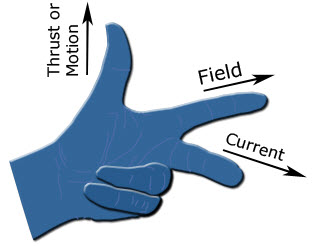 |
Fundamental Principals of Electric Motors and Generators
In a very fundamental sense, the motor-action and the generator-action can be differentiated and explained as below.
Fleming’s Left Hand Rule for Motors
In the motor action, we supply electric current that passes through coiled conductors resulting in magnetic inter-conductor action. The final result is that one set of conductors (the motor rotor) is forced to move and it moves anything attached to it. The circular movement of the motor rotor tells us that in this action we have converted electrical energy into mechanical energy.
We can use a common wound-rotor type induction motor to explain it further. In this type of motor we have a stator (which does not move) that has coiled conductors embedded in it. External electric power source is connected to the stator coils. The rotor is also provided with coiled conductors which form a set of complete circuits – but these circuits have no power source connected to them.
When the stator coils are energized, a magnetic field is created; this magnetic field induces a current in the rotor coils, which in turn creates a magnetic field around the rotor coils.
Since the two stator and rotor coils are very close to each other, the two electromagnetic fields interact and a force of repulsion is generated – which causes the rotor to rotate. We still have not discussed the direction of rotation – this is answered by Fleming’s Left Hand Rule.
This phenomenon was originated by John Ambrose Fleming, in the late 19th century, as a simple way of working out the direction of motion in an electric motor. The figure provided here illustrates the Left Hand Rule. When current flows in a wire, and an external magnetic field is applied across that flow, the wire experiences a force perpendicular both to that field and to the direction of the current flow. A left hand can be held, as shown in the illustration, so as to represent three quantities.
The direction of force generated by the electromagnetic field will be given by the direction to which the thumb points.